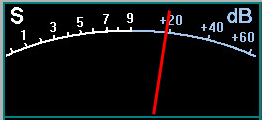I decided early on that I would complete all the modules and have Pic-A-Star working on a breadboard before building a case.
In designing the case, key decisions were:
- Whether to have the key pad on the right or the left of the display.
- Whether to have an analogue meter - which would increase the size of the front panel.
- What material to use: ie a metal (aluminium) case or a case made of double sided PCB.
Initial Decisions:
- I decided on left keypad, no analogue meter and double sided PCB.
- The case is 108mm high which is the height of the aluminium box for the PA plus 3.5mm to allow for the thickness of the top and bottom panels above and below it.
- This gives enough height beneath the BPF unit for the G6ALU timer and logic boards to be mounted vertically facing each other.
Construction:
- The front panel was made first as it is the most difficult part and its layout defines the position of internal partitions.
- Printouts of the keypad labelling overlay and display board layout were glued on to guide drilling and cutting.
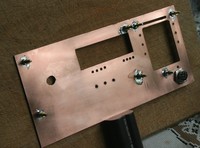
Rear view of front panel showing pan-headed 3mm brass plated screws soldered in place to support the display and status boards.
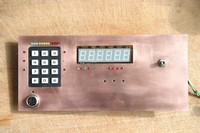
Front view: A piece of red filter material will be positioned behind the panel
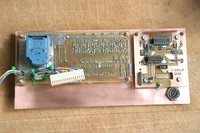
Rear view: The leftmost cable is to the keypad and will be shortened and rerouted.

Detail of display board and rotary encoder mounting.
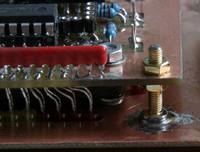
Positioning and soldering the brass screws
was easy. They were fixed to the boards and the nuts adjusted to
have the screws resting on the back of the panel. Spray flux was applied before
soldering.
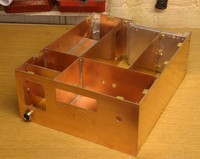
The case completed. Note the rectangular
cut-out in the fore-aft partition at the rear. Partition wasn'twanted here
but strips of PCB retained at top and bottom to brace the back of the case
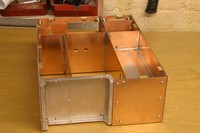
The PA + heatsink are on a U-shaped aluminium sheet forming the top, bottom and back of the PA enclosure. The BPF compartment is on the right. Brass shin was soldered to the long outer edges of the the underside of the BPF unit (in addition to the recommended central shim). The floor of the comapartment has been tinned to provide better contact (bare copper will corrode)
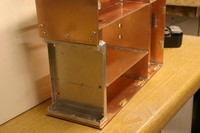
Further view showing construction of PA compartment. To join PCB to aluminium, brass angle from B&Q was soldered to the PCB board and screwed to the aluminium.
